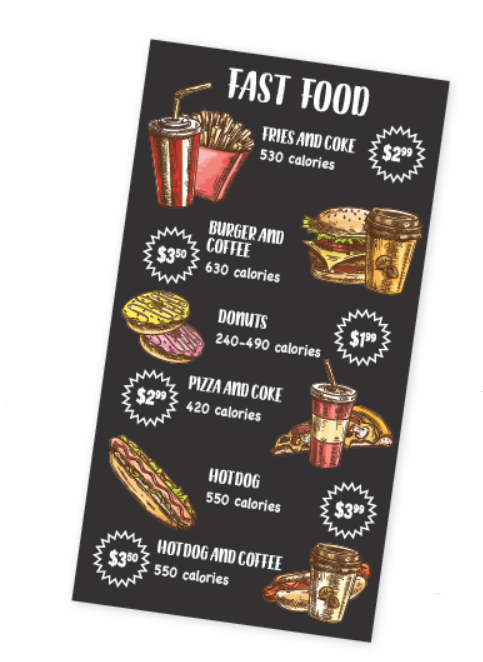Whether you sit down, drive through, take out, or pick up, you should see calorie information on the menus of all chain restaurants with 20 or more locations. Even prepared foods at your supermarket or coffee shop chain and popcorn at that big-name movie theater may need to be tagged with calorie content on menus.
This law was designed to help consumers make better choices to cut calorie intake, thereby slowing the growing obesity epidemic and cutting down on the related increase in chronic conditions like heart disease and diabetes. To date, research indicates the menu labeling law has not had a huge impact on our behavior (see “The Impact of the Menu Labeling Law” box), but it does have the potential for good for those who use it.
What to Do: “Decision making around food choices is complex,” says Jason P. Block, MD, MPH, an associate professor of population medicine at Harvard Medical School who has conducted extensive research on the impact of menu labeling. “We make our choices based on factors such as taste, convenience, and price. But calories and other nutrition information can be a useful additional piece of information when we’re trying to decide between two or three items or debating if we want that drink or side.”
If it has been recommended you aim for a particular calorie range as part of a weight management strategy, menu labeling can help you see where a meal fits into your calorie allotment for the day. But if your primary focus is health and wellness, calories are not the only factor to consider. For health in general, your overall dietary pattern is more important than calorie-counting alone.
“Tufts research has shown that foods people eat at restaurants are, on average, much less healthy than foods consumed from grocery stores, worksites, or schools,” says Dariush Mozaffarian, MD, DrPH, dean of the Friedman School and editor-in-chief of Tufts Health & Nutrition Letter. “As long as that’s true, focusing on lower calorie choices can be helpful, but it will only get you so far, health-wise. It is possible for healthier foods to have higher calories than less healthy foods.”
“In terms of raising awareness, this law has been a win,” says Block. “Research shows customers recognize calorie information is available to them, and many report using it in decision making.” The jury is still out, however, on whether this knowledge is actually changing our behavior. A study by Block and colleagues analyzed millions of purchases at a national fast-food chain and found a relatively modest decrease in calories (about 60 calories) per transaction after the start of labeling.
There are some hints that restaurants are changing their menus or reformulating high-calorie foods, although this is not necessarily due to labeling laws. “There has been a general change in the marketplace in the last six or seven years, with restaurants more actively promoting healthy foods in response to consumer demand,” Block explains. “We’re still trying to work out what role, if any, labeling laws have played in this change.”
A recent study by Tufts researchers modeled the potential health impact of menu labeling, with impressive results: Junxiu Liu, PhD, a postdoctoral scholar at the Friedman School and lead author of the study explains: “Our simulation study found that consumers’ response to the menu labeling policy could prevent nearly 136,000 cardiovascular disease events and almost 100,000 cases of type 2 diabetes population-wide over a lifetime, adding nearly 370,000 years of life and saving over $10 billion in healthcare costs,” says Liu. “The potential health gains and cost savings would be twice as large if there is also modest restaurant menu reformulation to provide healthier items.”
Try these tips when ordering restaurant food:
- Compare calories in the foods you plan to order to your overall calorie needs for the day (2,000 calories is a typical daily upper limit).
- Look for healthy menu choices, such as those with more fruits, vegetables, beans, and whole grains and less sodium, refined grains, and added sugars. Try seafood (not breaded and fried) over red meat more often and look for healthy plant oils rather than butter. A salad with olive oil dressing is a healthier choice than a deli sandwich, regardless of calorie content.
- Plan ahead: Complete nutrition and ingredient information (beyond calorie content) is available at company websites. Before ordering takeout or heading out to eat, use it to identify options lower in sodium, added sugars, or refined carbohydrates, for example, and higher in unsaturated fats, fiber, or vitamins and minerals.
























